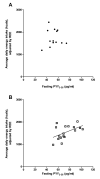Gut hormone activity of children born to women with and without gestational diabetes
- PMID: 23364910
- PMCID: PMC3651744
- DOI: 10.1111/j.2047-6310.2012.00140.x
Gut hormone activity of children born to women with and without gestational diabetes
Abstract
What is already known about this subject Children born to women with gestational diabetes have greater risk for obesity. Obesity in adults and children is associated with blunted postprandial gut hormone responses. What this study adds Children of women with gestational diabetes have a blunted postprandial response of GLP-1. Children of women with gestational diabetes have high fasting PYY concentrations.
Background: Intrauterine exposure to gestational diabetes mellitus (GDM) increases risk for obesity. Obesity is associated with a blunted postprandial gut hormone response, which may impair satiety and thereby contribute to weight gain. The postprandial response of gut hormones among children of women with GDM has not previously been investigated.
Objective: To examine whether children of women with GDM have suppressed peptide-tyrosine-tyrosine (PYY) and glucagon-like-peptide-1 (GLP-1), and higher concentrations of ghrelin, following a meal challenge. A secondary objective was to investigate associations of these hormones with children's free-living energy intake.
Methods: Children (n = 42) aged 5-10 years were stratified into two groups: offspring of GDM mothers (OGD) and of non-diabetic mothers (CTRL). Body composition was measured by dual-energy X-ray absorptiometry, and circulating PYY, GLP-1 and total ghrelin were measured during a liquid meal challenge. Energy intake was assessed by three 24-h diet recalls.
Results: Between-groups analyses of fasting and incremental area under the curve (AUC) found no differences in ghrelin. Incremental AUC for GLP-1 was greater among the CTRL vs. OGD (P < 0.05), and fasting PYY, but not incremental AUC, was higher among OGD vs. CTRL (P < 0.01). Associations of fasting and incremental AUC for each gut hormone with children's usual energy intake did not differ significantly by group.
Conclusions: Further research is needed to more fully examine the potential role of postprandial GLP-1 suppression and high-fasting PYY concentrations on the feeding behaviour and risk for obesity among children exposed to GDM in utero.
Keywords: GLP-1; Ghrelin; PYY; obesity.
© 2013 The Authors. Pediatric Obesity © 2013 International Association for the Study of Obesity.
Figures





References
-
- Boney CM, Verma A, Tucker R, Vohr BR. Metabolic syndrome in childhood: association with birth weight, maternal obesity, and gestational diabetes mellitus. Pediatrics. 2005;115:e290–296. - PubMed
-
- Gillman MW, Rifas-Shiman S, Berkey CS, Field AE, Colditz GA. Maternal gestational diabetes, birth weight, and adolescent obesity. Pediatrics. 2003;111:e221–226. - PubMed
-
- Wiedmer P, Nogueiras R, Broglio F, D’Alessio D, Tschöp MH. Ghrelin, obesity and diabetes. Nat Clin Pract Endocrinol Metab. 2007;3:705–712. - PubMed
-
- Cummings DE, Purnell JQ, Frayo RS, Schmidova K, Wisse BE, Weigle DS. A preprandial rise in plasma ghrelin levels suggests a role in meal initiation in humans. Diabetes. 2001;50:1714–1719. - PubMed
Publication types
MeSH terms
Substances
Grants and funding
LinkOut - more resources
Full Text Sources
Other Literature Sources
Medical

